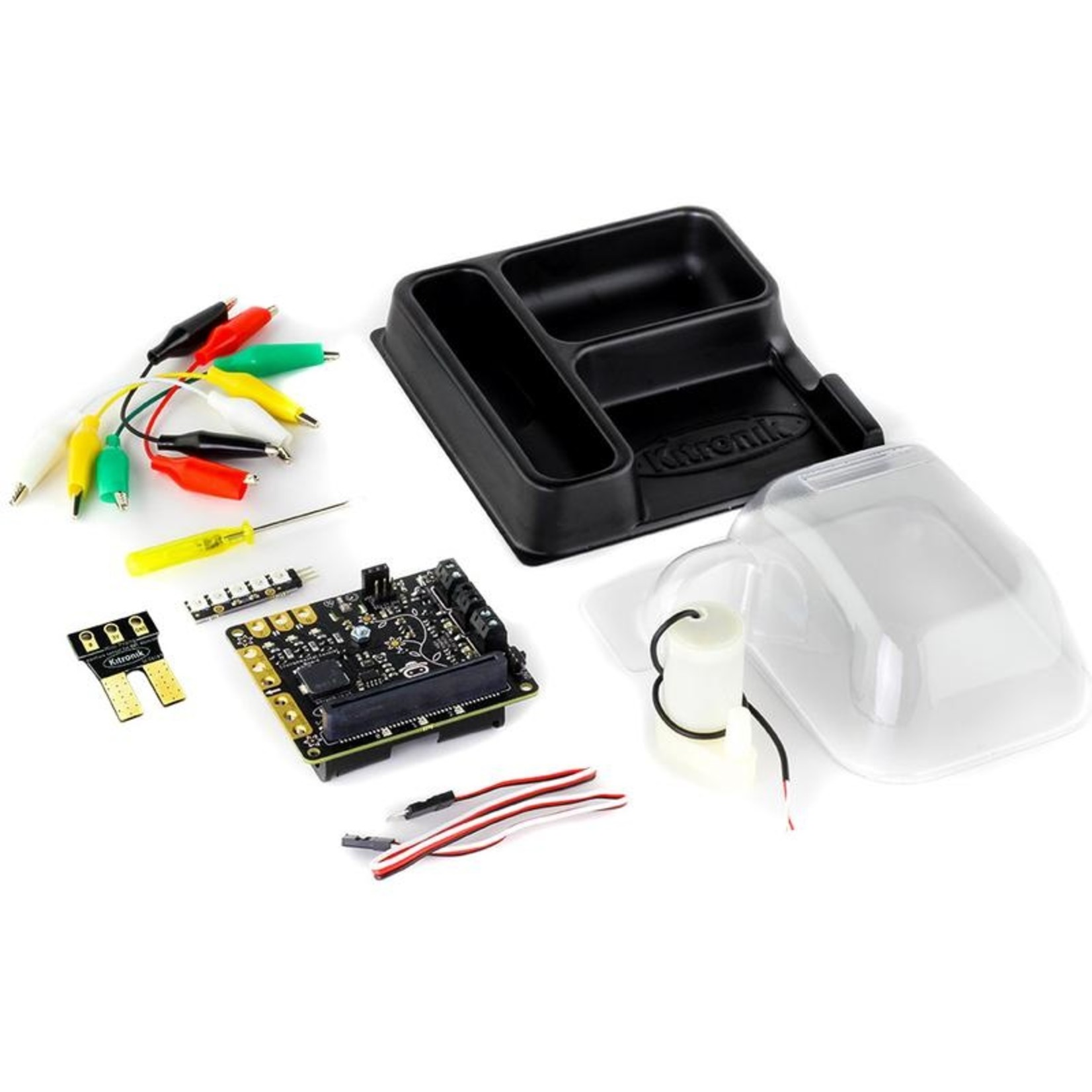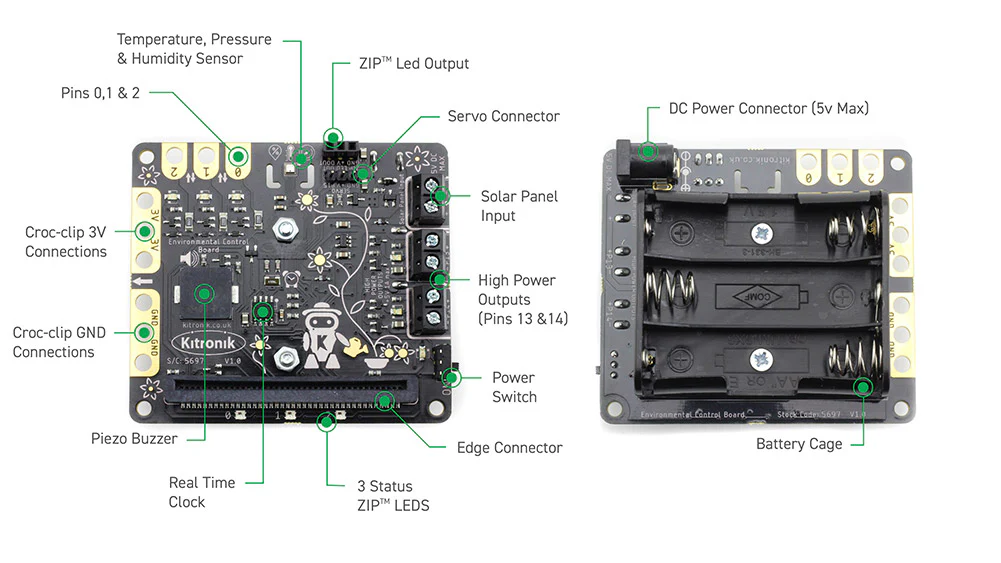Unlock the secrets of nature with code, engineering, and the Kitronik Smart Greenhouse Kit for BBC micro:bit!
The Kitronik Smart Greenhouse Kit for the BBC micro:bit provides an exciting way to learn about the relationship between plants and their environment. The user will learn how to monitor environmental conditions and then how to build automated systems that react to them. Grow a crop of plants with this smart greenhouse that can be coded to monitor and automatically water them so that you can get them growing perfectly. This kit is compatible with both the micro:bit V1 and the new microbit V2, available separately.
The kit comprises a two-part plastic greenhouse, Kitronik environmental control board, water pump, Kitronik ZIP Stick, and Mini Prong soils moisture sensor. Also included are 5 crocodile clips, ZIP extension cable and a small screwdriver. Just add a micro:bit, seeds, and then some water and you will have everything you need!
The kit also ships with detailed assembly and coding instructions that will get you up and cultivating in no time. There are also 7 online MakeCode tutorials that build in complexity as you progress through them. They cover everything from gathering sensor data and having the system automatically react to it, to visual user interfaces and more. It is recommended that the user/student complete the tutorials in order for the best learning experience.
At the heart of the micro:bit controlled Kitronik Smart Greenhouse Kit is the Kitronik environmental control board. This board provides a variety of sensor inputs and connection points for the BBC micro:bit (V1 & V2) and provides the ability to control outputs for devices such as a water pump, fan, servo or heater pad. This makes it ideal for feedback control systems, such as the smart greenhouse kit.
The environmental control board can be coded with the MakeCode editor and Kitronik have produced a set of custom blocks to make the job as simple as possible. There are blocks for reading input and for controlling additional devices such as a pump. This can be added via the add Extensions function in the editor by searching “Kitronik” or from https://github.com/KitronikLtd/pxt-kitronik-smart-greenhouse.
The default crop for these types of experiments is often cress, as it is quick growing, requires little tending, and can be harvested when they are approximately 5cm tall (within a few days). Cress is also practically a superfood, this alone could easily become the subject of an entire lesson. Despite all of its benefits, cress is not the only option. There are other sprouting plants, such as sprouting white mustard, which also grows quickly and can be harvested when they are 5cm tall. You can also look into micro-herbs/micro-greens, these too are usually ready to harvest within a week and offer an excellent and aromatic alternative. Once you have chosen your preferred crop type you then need to choose a suitable soil.
Note:
- This kit does not come with a BBC micro:bit but will work with either a BBC micro:bit V1 or a BBC micro:bit V2.
- This kit is not waterproof. If you get the board wet, please turn off and allow to fully dry. Risk of shock is very small, but please be cautious.
Features:
- Build automated growing systems that react to changeable environmental conditions with the Kitronik Greenhouse Kit.
- This kit is compatible with both micro:bit V1 and microbit V2.
- The kit comes with detailed assembly and coding instructions.
- At the heart of the kit is the kitronik Environmental control board that was specifically designed to be the control hub for this kit.
- Key features of the Environmental control board are;
- The board features a number of sensor inputs that can be coded to control the board's outputs.
- There is an onboard BME 280 environmental temperature, barometric pressure and humidity sensor and a separate Real-Time Clock (RTC).
- The board also features an onboard piezo buzzer, 2 1A outputs (ideal for a water pump, heater pads or fan), 3 status ZIP LEDs, a ZIP LED expansion connector and servo output. In addition to these, 3 BBC micro:bit pins are broken out to croc-clip connections as further inputs and outputs, along with pads for 3V and GND.
- It can be powered via the onboard 3xAA battery holder or the 2.1mm DC Jack, and the power controlled via the on/off switch with an adjacent LED indicator.
- There are also 7 online MakeCode tutorials that introduce you to all of the features of the board.
- Crops such as cress, sprouting white mustard and micro-herbs/micro-greens are ideal for use with this kit.
- Code it with the MakeCode editor using the Kitronik custom code blocks for the Environmental control board.
Contents:
- 2 x Moulded plastic greenhouse enclosure parts.
- 1 x Kitronik Environmental Control Board for micro:bit.
- 1 x Water Pump.
- 1 x Kitronik ZIP Stick.
- 1 x Mini Prong Moisture Sensor.
- 5 x Crocodile Leads.
- 1 x ZIP extension cable.
- 1 x Screwdriver.
- User guide Booklet, containing assembly and coding instructions.
Video:
Requires:
- A web browser and an internet connection
- BBC micro:bit
- 3 x AA Batteries or plug-in power supply with USB to DC Jack.
- Seeds, such as cress.
- Soil.
Resources:









